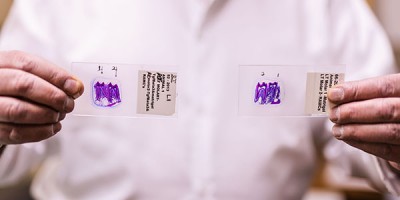Newswise — Recombinant human transforming growth factor-β3 (hTGF-β3), which helps form bone, has been linked to shrinking malignant tumours. This novel application is a welcome addition to cancer therapy research.
Professor Ugo Ripamonti, Director of the Wits Bone Research Laboratory in the Faculty of Health Sciences, has shown that while hTGF- β3 is a potent initiator of new bone, it can retard and stop the growth of human oral squamous cell carcinoma.
Human oral squamous cell carcinomas (hsCCs) are the most common head and neck cancers in southern Africa, says Ripamonti. “We are seeing that head and neck cancers are presenting with more aggressive biological and clinical features. This is due to an increase in smoking, alcohol, and viremia – which is the presence of viruses in the blood.”
He says it is still unknown how the hTGF-β3 can target cancer, but the protein has been shown to act differently in many contexts. “For example, we see it can make substantial new bone in primates. It can also heal large mandibular defects. hTGF-β3 is really incredible and the research into what the protein can do is novel and exciting,” he says. Indeed, clinical trials conducted at Wits University have revealed the feasibility of using hTGF-β3 to reconstruct mandibular [lower jaw] defects in humans.
Cancer treatment promising in mice
Meanwhile, mice were implanted with squamous cell carcinomas taken from biopsies of a person’s oral cavities for the cell carcinoma study. When the mice were injected with relatively high doses of hTGF-β3, histology and molecular biology results showed that the cancers turned into non-malignant cell carcinomas. In other words, the cancer markers changed, and the tumours were stopped in their tracks.
These mice, know as athymic mice, cannot reject cancer cells because they have been genetically prepared without T-lymphocytes, the T-cells that fight infection. The transplanted human oral squamous cell carcinomas took three weeks to graft into the chest cavities of the mice before the treatment was undertaken.
Developing countries urgently need more cancer treatment options
Ripamonti says that developing countries will shoulder the increasing global cancer burden. With demographic trends shifting (urbanisation, population growth, ageing and a decreased incidence of infectious diseases), coupled with tobacco, alcohol consumption and dietary changes, cancer will become more common, and unfortunately, more aggressive.
However, cancer treatments are costly, particularly in already resource-constrained public health settings.
An article in the Frontiers in Public Health journal notes that the survival rate of different cancers is lower in developing countries. Historically, these countries have poorer early detection programmes, disease prevention initiatives, cost-effective treatment, and cancer care infrastructure.
Another study profiling Africa reveals that 1.1-million new cancer cases and 711 429 related deaths occurred in 2020. Furthermore, due to the changing demographics and rising populations, the cancer burden is set to increase to 2.1 million new cases and 1.4 million deaths by 2040 in Africa.
Currently, the main cancer treatments on the continent include surgery, radiotherapy and systemic therapies. The latter refers to hormonal therapy, targeted therapy and chemotherapy. But, these are not always available on time and have a prohibitive price tag.
While cancer care should address barriers to care and other systemic failures of the system, clinical research must address the limited medical options.
“The use of hTGF- β3 is of course a new option and we’re talking with oncology specialists. Like most research, it will take some time because our research is novel and seen as controversial,” says Ripamonti. “The Bone Research Lab at Wits is the only bone research unit that has shown that hTGF-β3 is a powerful initiator of new bone and can alter the progression of human squamous cell carcinoma growth.”
20231127105913.jpg&width=320&height=100)





